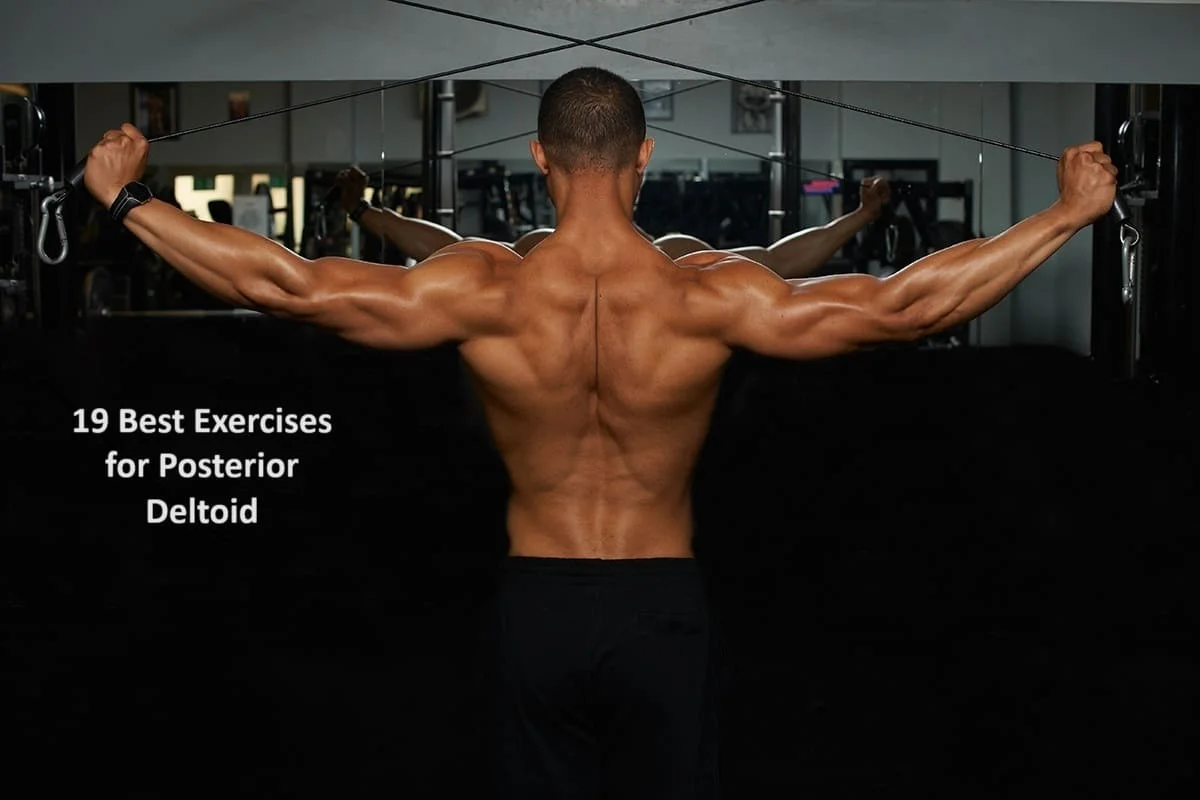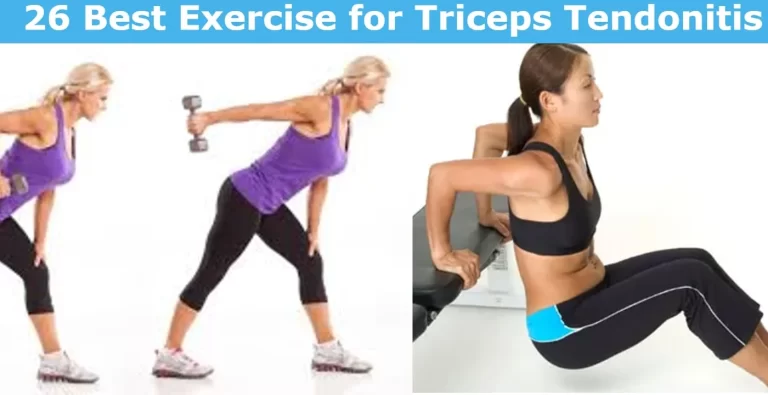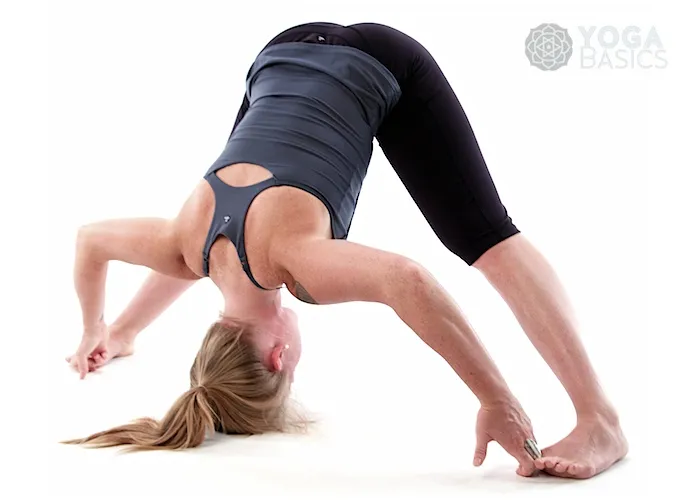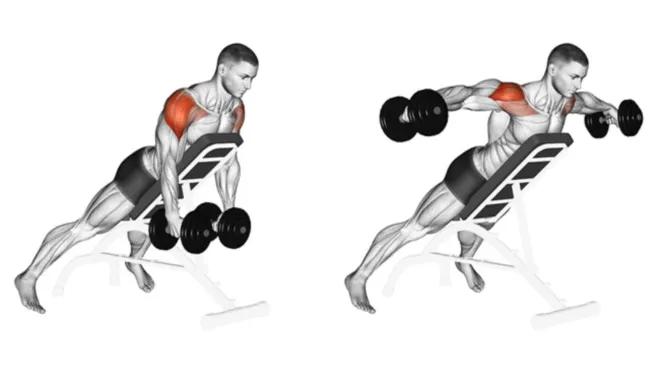19 Best Exercises for Posterior Deltoid
Introduction:
The deltoid muscles cover the upper portion of your shoulder. They aid in the front, side, and rear lifting of your arm. Pitchers, swimmers, and anybody else who performs repetitive overhead arm movements may have deltoid muscle soreness.
In addition to stabilizing the shoulder joints, the posterior deltoids aid in a variety of pulling motions. To give your shoulders a well-rounded workout, you might include a deltoid exercise in your regimen. Robust shoulders not only avert numerous practical advantages. Like throwing a baseball, you can effortlessly move a big suitcase and pass meals across the table. Additionally, effective shoulder exercise increases confidence.
Even though all of the muscles work together to support the shoulders during daily tasks like lifting large bags, growing and developing posterior deltoid strength may not be simple. Strengthening can be achieved using the posterior deltoid workouts listed here.
Exercises that build the deltoid muscle are crucial for strengthening the shoulder so that it can carry out all everyday tasks with greater strength. They also have numerous health advantages and reduce the chance of injury. When you move your hands out to the sides, your posterior deltoid muscle helps your shoulders as well.
How are injuries to the deltoid muscle treated?
The majority of deltoid muscle disorders are curable without surgery and include:
- Use ice packs or cooling compresses to reduce swelling.
- Either muscle relaxants or painkillers.
- Physical Therapy
- Exercises for the shoulders to increase mobility and strength.
- Make your shoulder immobile by wearing a sling or other supportive clothing.
- An injection of steroids to minimize pain and inflammation.
- Use warm compresses to ease tense muscles.
The advantages of Strength Training for the Posterior Deltoid:
Below are some advantages associated with consistent exercise:
- Improved muscular power
- Enhances the functionality of your everyday activities
- Exercises that strengthen the shoulders can enhance muscle function, posture, and healthy motion patterns.
- Relaxing muscles
- Decrease any tightness or stress.
- With exercise, you might be able to regain your mobility.
- Enhancing coordination.
- Exercises for the deltoid strengthen the upper back, shoulders, and arms.
- Regularly completing these exercises can help the patient move with ease and strength as well as treat and prevent shoulder problems.
- Those who frequently sit or bend forward would benefit from this as it helps with posture.
The ideal workout for strengthening the posterior deltoid:
The finest workouts to help you improve your posterior deltoid strength are listed below.
Single-arm bent-over row
- Rest your left hand and knee against the bench.
- Maintain a straight left elbow.
- With your foot planted firmly on the ground for support, slightly extend your right leg behind you.
- Sustain a straight back and an equilibrium spine.
- Raise your right hand to a medium-to-heavy dumbbell grip while extending your arm towards the floor.
- To bring your upper arm about in line with your lower chest, bend your right elbow and pull it up and back.
- At the peak of the exercise, firmly compress your shoulder blades together.
- With control, reduce the weight.
- Go back to your neutral posture.
- Next, unwind.
- Carry out the opposite side.
- Do 5 to 10 repetitions of this workout each day.
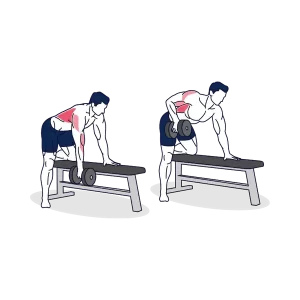
Standing bent-over lateral raise
- Grab a pair of dumbbells with your palms pointing in opposite directions.
- Place your feet shoulder-width apart, slant your knees slightly, and hunch forward at the hips while maintaining a straight back.
- The weights should be together beneath your chest, and your elbows should be relaxed.
- Raise your arms until they are parallel to the floor, spreading them out like wings.
- At the peak of the exercise, tense your shoulder blades.
- Slowly and carefully, return the weights to their initial position.
- Go back to your neutral posture.
- Next, unwind.
- Do 5 to 10 repetitions of this workout each day.
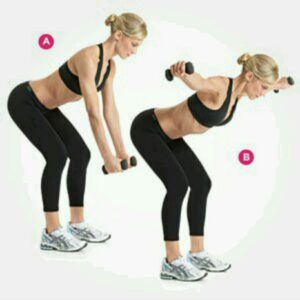
Cable machine high pull with Ropes
- Position yourself facing the cable machine with your feet hip-width apart.
- Attach the rope handle to the cable attachment after adjusting it to roughly chest height.
- Step back so that your arms are stretching in front of you while maintaining a hip-distance stance.
- As you pull the ropes towards you, they will separate. Maintaining a high elbow position will assist you in targeting those deltoids.
- Stretch your elbows back out to the beginning posture slowly and deliberately.
- Go back to your neutral posture.
- Next, unwind.
- Do 5 to 10 repetitions of this workout each day.
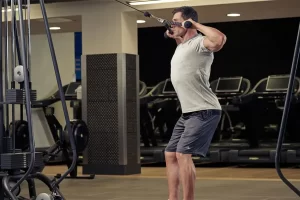
Rear deltoid machine
- Face the pad while sitting on the machine.
- You’ll appear to be sitting on it backward, but you’re perfectly positioned for this exercise.
- Adjust the seat height so that the handles in front of you are at the same level as your shoulders.
- Press your arms back, maintaining them straight or slightly bent, while holding the handles, palms down, or palms facing each other.
- Squeeze your shoulder blades together as if they were lift doors.
- Hold this position for 2 seconds.
- Then, with your hands in front of you, return to the starting position.
- Do this slowly and carefully.
- Then unwind.
- Every day, do this workout 5-10 times.
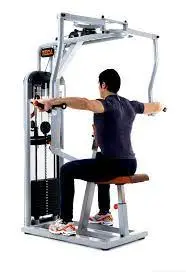
Assisted pullup
- On the machine’s side, adjust the weight deduction.
- Select the appropriate quantity and set.
- Once the knee pad is low enough for you to rest both knees on, climb onto it and push it down.
- You should have hip-width between your knees.
- With your palms facing away from the center, grasp the outer handles above you.
- Lower yourself to the beginning position while extending your arms.
- Raise your chin to meet or surpass the handles by pulling your torso upward.
- Keep the posture for a short while.
- Then calmly lower yourself down.
- Maintaining your shoulder blades engaged is important.
- Press them down and back again.
- Next, unwind.
- Do 5 to 10 repetitions of this workout each day.
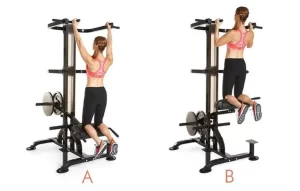
Side-lying external rotation
- While lying on your side, grasp a small dumbbell.
- With your elbow bent 90 degrees, place your upper arm on your side.
- Put a towel roll in between your upper arm and your torso if you have broad shoulders.
- As much as you can, rotate your arm around your torso while keeping your upper arm fixed to the body.
- Shortly after a little moment of holding it.
- Carefully return it to the beginning position.
- Next, unwind.
- Do 5 to 10 repetitions of this workout each day.
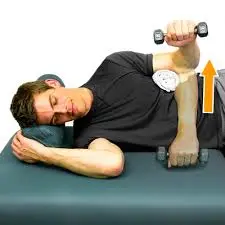
Dumbbell Reverse Fly
- Place both hands on dumbbells and place your feet shoulder-width apart.
- Sit on a bench.
- Reposition your hips.
- Hinge forward by pushing your chest forward.
- Ensure that your upper body is in line with the planet’s surface.
- With your palms facing each other, hang your arms straight down.
- Raise your arms gradually to the sides until they are shoulder level, making sure your elbows are slightly bent.
- Once you’ve completed this specific action, make sure to push your shoulder blades together.
- Return to the starting position gradually.
- Next, unwind.
- Do 5 to 10 repetitions of this workout each day.
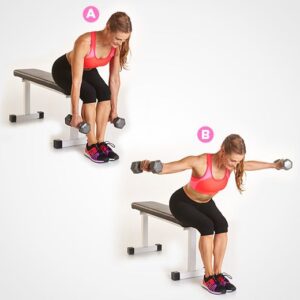
Dumbbell Bent-Over-Row
- Place your feet hip-width apart and grasp dumbbells in your hands.
- As you advance in a hinge motion, push your hips back until your torso is parallel to the floor.
- Make sure your center is active.
- Make sure your palms are facing each other and hang your arms straight.
- Verify that you have a flat back.
- Pull the weights up to your side and flex your shoulder blades.
- Return to the starting position gradually.
- Next, unwind.
- Do 5 to 10 repetitions of this workout each day.
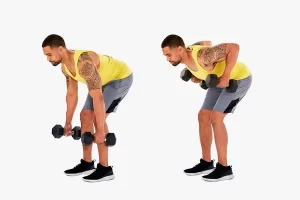
Band Pull-Apart
- With your feet shoulder-width apart, take a tall stance and place your palms face down on a long resistance band in front of you.
- Place your hands shoulder-width apart and at shoulder height.
- Squeeze your glutes, tuck your hips, and bend your knees slightly as you plant your feet on the ground.
- Press your shoulders down, tuck your head down, and engage your core.
- Sustain this tenseness.
- Breathe in and out while you pull your band apart, bending your elbows slightly or maintaining your arms straight.
- Pull till the point where the compression of your shoulder blades causes your back delts to contract.
- Feel the contraction in the backs of your shoulders by holding for a little moment.
- Breathe in, resist the band’s resistance, and slowly bring your hands back to the beginning position.
- To pull again and again, exhale.
- Next, unwind.
- Do 5 to 10 repetitions of this workout each day.
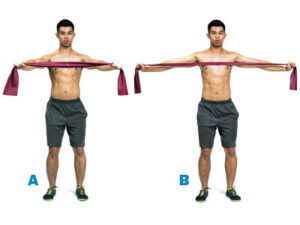
Standing Cable Face Pull
- At eye level, fasten the rope attachment to a cable machine.
- Using an overhand hold and your hands facing each other, grab the ends.
- Maintaining your arms straight, take a step backward while facing the cable machine until you experience enough resistance and strain.
- Maintain a shoulder-width gap between your feet.
- Squeeze your glutes while bending your knees slightly and keeping your hips tucked in.
- As you bring the rope up to your face, take a breath and release it.
- Squeezing your shoulder blades together will cause your back delts to ache.
- Pause here, keeping your elbows raised.
- With your arms back in the beginning position, slowly release the tension that the cable is providing.
- Next, unwind.
- Do 5 to 10 repetitions of this workout each day.
- Once the rope’s ends are on either side of your face, flex your elbows and continue pulling.
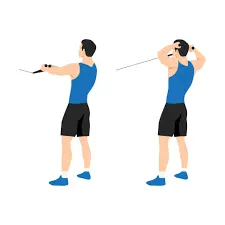
Wide-Grip Pull-Up
- Using an overhand grip and hands broader than your shoulders, grab your bar.
- Lift your feet off the floor.
- To work your back and lats, droop your shoulders.
- Feel your rear delts helping to rotate your shoulders outward.
- Bring your head back and contract your glutes and core.
- To experience the tension, linger here.
- Breathe in and out to raise yourself up.
- Raise your torso to the bar and consider pushing your elbows slightly behind you and down towards the floor.
- Lift your chin off the counter.
- At the peak, squeeze your shoulder blades together and downward.
- Repeat after lowering yourself gradually while keeping your arms completely straight.
- Next, unwind.
- Do 5 to 10 repetitions of this workout each day.
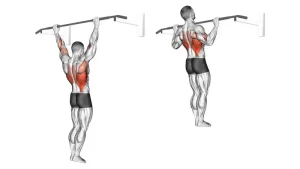
Wide-Grip Lat Pulldown
- Fasten a broad bar onto a lat pulldown apparatus.
- Sit up straight, place your feet flat on the floor, and reach the bar with ease by adjusting your seat.
- Using an overhand grip and hands broader than your shoulders, grab the bar.
- Pull your head back, contract your abdomen, and droop your shoulders.
- While you gently recline back, maintain this tension and a straight spine.
- As you bring your bar down to your chest, take a breath and release it.
- Consider bringing your elbows close to the ground.
- Maintain a straight wrist position.
- Feel your back delts by squeezing your shoulder blades together and down towards the bottom.
- Go back to where you started with your bar and push through the resistance to get back up.
- Next, unwind.
- Do 5 to 10 repetitions of this workout each day.
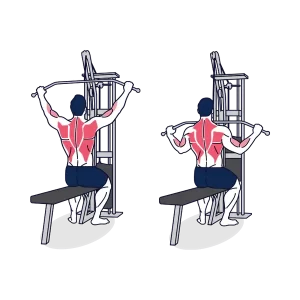
Single-Arm Dumbbell Row
- Carry your dumbbell in one hand while standing behind a bench.
- Once your torso is parallel to the floor, hinge your hips back.
- Put the hand you are not using on the bench in front of you.
- Maintain a neutral spine by contracting your glutes and using your abs.
- Bend your knees just a little bit.
- Pull your head back softly and tuck your chin in.
- Lower both shoulders.
- Take a breath and release it to row the dumbbell.
- While keeping your elbow close to your body, imagine lifting it back and behind you.
- Squeeze the top of your shoulder blade after feeling it fully retract.
- During the exercise, pay close attention to contracting your rear delt.
- Breathe in to return your weight to the beginning position gradually.
- Maintain an externally rotated and depressed shoulder by engaging your rear delt at the bottom.
- Throughout the workout, maintain your neutral spine by using your abs.
- Next, unwind.
- Continue on the opposite side.
- Do 5 to 10 repetitions of this workout each day.
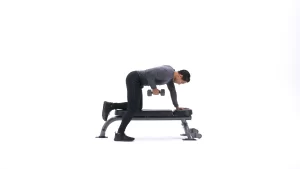
Seated Bent-Over Row
- With your feet flat on the floor and hip-width apart, sit tall and with a straight spine.
- Take a dumbbell in both hands, with the palms facing each other.
- To make your back flat and parallel to the ground, or as close to parallel as possible, hinge forward at the hips.
- Keep the dumbbells close to your ankles as you extend your arms toward the ground without touching them.
- Squeeze your shoulder blades together as you row the dumbbells towards your rib cage’s sides.
- Avoid arching your back and maintain a neck alignment with your spine.
- For a moment, hold at the top.
- Gradually restore the dumbbells to their initial position.
- That amounts to one rep.
- Then gradually make your way back to the beginning.
- Next, unwind.
- Do 5 to 10 repetitions of this workout each day.
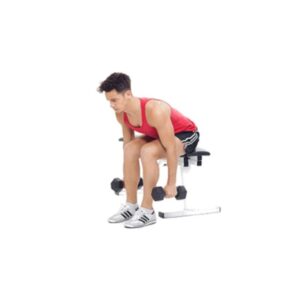
Dumbbell Arnold presses
- Stand out using a dumbbell in each hand and your feet hip-width apart.
- With your palms facing inside, curl the weights inward until they are forced up against your shoulders.
- Maintain a straight spine and contract your core.
- Raise the weights and twist your arms until your arms are fully extended upward and your palms are facing ahead.
- Hold on for a little while.
- Return to the starting position gradually.
- Next, unwind.
- Do 5 to 10 repetitions of this workout each day.
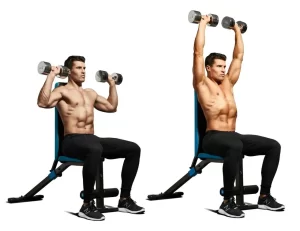
Incline dumbbell Y raises
- Press your stomach against the bench as you lie there.
- To support your weight on your toes, extend your feet backward.
- Place your hands palms inside out as you hold your weights beneath your shoulders.
- Raise the weights and form a “Y” with your arms.
- Pull your shoulder blades forward and contract your core as you reach maximum extension.
- Hold on for a little while.
- Then gradually make your way back to the beginning.
- Next, unwind.
- Do 5 to 10 repetitions of this workout each day.
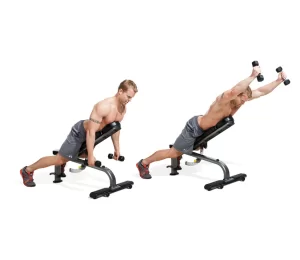
Inverted Rows
- Begin by lying down beneath the racked bar on your back.
- Raise your arms and place your hands slightly wider than your shoulders to hold the bar.
- With your palms facing away from your body, use an overhand grip.
- Lean over the bar and let yourself go.
- Your feet should be hip-width apart and your hands should be positioned above your shoulders.
- Raise until your chest makes contact with the bar.
- From your toes to the top of your head, your body should remain in alignment.
- Hold for a little moment before lowering yourself gradually.
- Then gradually make your way back to the beginning.
- Next, unwind.
- Do 5 to 10 repetitions of this workout each day.
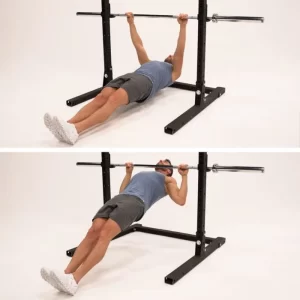
Dumbbell Y-T-I Raise
- Place yourself facedown on a bench or stability ball and grasp a dumbbell in each hand.
- With your palms facing each other, extend your arms straight down towards the ground.
- Form a “Y” shape with your arms raised at a 45-degree angle while maintaining a neutral head.
- Just a moment of silence. Subsequently, return the weights to their initial position.
- Raise the weights once more, extending them straight out to your sides in the shape of a ‘T’, with your palms pointing down.
- At the peak of the exercise, pause a little before lowering the weights.
- Lastly, elevate the weights by extending them straight behind you so that your palms face each other and form an “I” configuration.
- After a little moment, release the weights.
- Then gradually make your way back to the beginning.
- Next, unwind.
- Do 5 to 10 repetitions of this workout each day.
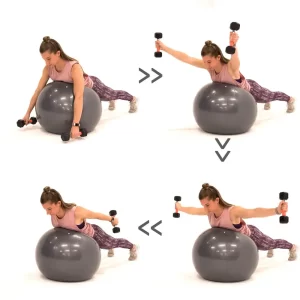
Quadruped Rear Delt Raise
- Place your knees beneath your hips and your palms beneath your shoulders to begin on all fours on a mat.
- With your right hand, grasp a dumbbell.
- As you raise your right arm out to the side, your shoulder’s back should feel the strain.
- Try not to twist to the side, brace your core, and maintain a straight back.
- Return the dumbbell to the starting position. That amounts to one rep.
- After doing all of your repetitions on one side, switch sides.
- Then gradually make your way back to the beginning.
- Next, unwind.
- Do 5 to 10 repetitions of this workout each day.
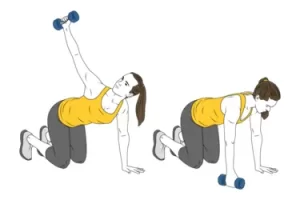
Precautions When Performing Deltoid Strength Exercises:
The following are the precautions that you must take when performing deltoid strength exercises:
- If you are not comfortable performing a particular activity, do not do it.
- Take your time with the exercise. There is no need to hurry.
- You must utilize the correct equipment. Wear appropriate loose-fitting clothing and comfy shoes.
- Before exercising, make sure you warm up properly.
- While exercising, make sure to drink plenty of water every 20 minutes.
- As you work out, keep your back straight.
- Stop exercising if you are experiencing substantial discomfort.
- If you experience any discomfort or pain while completing any workout, stop immediately.
When did the patient stop performing the activity to strengthen their Deltoid?
Exercises targeting the posterior deltoid should be avoided in the following circumstances:
- The patient should not perform this exercise if he already has shoulder pain.
- If the patient was instructed to rest by the physician.
- If a recent fracture to the arm bone occurred.
- Weightlifting workouts should be avoided if the patient suffers from back pain.
- If the patient experiences any discomfort or shoulder ache while performing this exercise.
- If a patient’s doctor has advised against performing these exercises, they should not do so if they are sick or have a fever.
- If a person has aching muscles, they should refrain from exercising.
- If a person is sleep deprived, they can omit the posterior deltoid exercises.
Conclusion:
In addition to being crucial shoulder stabilizers, the posterior, or rear, delts, are key shoulder muscles engaged in numerous pulling motions. Strengthening them makes sense if you want to maintain good shoulder mobility. When attempting these exercises for the first time, consult a healthcare provider as with any fitness regimen.
Working with a certified trainer is also a smart option to ensure that you are utilizing the machines safely and effectively. These exercises will assist in counterbalance the heavier, front-loaded movements seen in other popular gym exercises if you’re trying to build your shoulders in a balanced manner.
FAQ
Why do fragile deltoids occur?
Deficits in the coordination of nerve muscles or even tendons can cause weakness in the shoulder. Weak shoulders will frequently improve with the steadily increased strengthening regimen. Shoulder weakness that does not improve with these workouts could be caused by a nerve injury or rotor cuff problem.
The way can the posterior deltoid muscle be strengthened?
Bent-over rows using a barbell.
Cobras with bodyweight stability balls.
Arnold does dumbbell presses.
Dumbbell flybacks in reverse.
Dumbbell Y is raised incline.
Dumbbell rows with an inclined back delt.
What is the posterior deltoid’s primary function?
In order to stretch this muscle, reverse the motion by flexion, internal rotation, and horizontal adduction of the shoulder joint. The posterior deltoid muscle’s principal functions are extension, external rotation, and horizontal abduction.
How are posterior deltoid fibers stretched?
Start the posterior deltoid stretch with your spine straight, whether you’re standing or sitting down. Let your shoulders drop. Gently grasp one arm by your upper arm with your other arm or wrist while you extend it across your body.
With deltoid soreness, should I still work out?
When performing exercises, it is OK to push through soreness or stiffness, but not severe pain, pinching pain, or catching. Stretching to the point of discomfort is the goal, but not too much beyond. Pushing to the right limit will gradually instruct the body on how to heal and extend in order to increase the range of motion.
Does strengthening the rear delts help with posture?
Stronger shoulders can also aid in your stability during big lifts such as the incline bench press or any of the unstable movements where dumbbells and benches collide. We all suffer from slouched workstation posture, which can be corrected with strong back delts.
What exactly is the posterior deltoid?
The rear deltoids that support arm retraction are called posterior deltoids. They attach to your shoulder blade’s flat surface. When you pitch a baseball, your rear delt muscles are used.
How can I maintain the health of my deltoid muscles?
Look after your deltoid muscles as follows:
following safety regulations unique to a given sport, such as baseball’s pitch-count limitations.
If your shoulder muscles hurt, don’t stretch them.
Taking a break from heavy overhead arm movements to allow the shoulder muscles to recover.
Warm up and stretch the shoulder muscles before engaging in any exercise.
Utilizing good form when swimming, throwing, or engaging in other activities involving repetitive shoulder motions.
Which workouts concentrate on the deltoids?
Push-ups, dumbbell front raises, cable diagonal raises, battling ropes, barbell upright rows, bent-arm lateral raises, 45-degree incline rows, and seated rear lateral raises were among the exercises on the list.
What is the deltoid’s primary purpose?
Your deltoid muscles enable you to move your arms in various planes. Additionally, they stabilize and safeguard your shoulder joint. The deltoids are skeletal muscles, just like the majority of other muscles in your body.
What advantages does the deltoid offer?
One of the major muscle groups in your upper body is your deltoid muscles. They are quite mobile and have connections to a lot of different muscles and bones in the upper back, neck, and shoulder area. They support you in performing daily tasks like lifting, pushing, and tugging while maintaining the equilibrium of your upper body.
References
- March 10, 2023, Cpt, K. S. Six Exercises to Strengthen the Posterior Deltoid Muscle. Reference: Healthline. https://www.healthline.com/health/fitness-exercise/rear-delt-exercises
- On December 28, 2022, Prajapati, N. Exercise for strengthening the deltoid muscles: health benefits, how to do it? Samarpan Clinic for Physiotherapy. Exercises for strengthening the deltoid muscles can be found at https://samarpanphysioclinic.com. Citation within the text: (Prajapati, 2022)
- Exercise For Posterior Deltoid 320: How to Perform the Exercise & Limitations.3 November 10, 2023. Insurance for numbers. https://www.godigit.com/health-insurance/exercise/exercise-for-posterior-deltoid. Citation in the text:( “Exercise For Posterior Deltoid 320: How to Do the Exercise & Precautions,” 2023)
- J. Zucker, August 7, 2023. The 8 Best Rear Delt Exercises for More Powerful, Round Shoulders. BarBend (https://barbend.com/best-rear-delt-exercises/). Citation: (Zucker, 2023)
- A. Breitowich, September 13, 2023. According to a trainer, these are the best rear delt exercises for sculpted shoulders. Female Health. https://www.womenshealthmag.com/fitness/g42747307/best-rear-delt-exercises/. Breitowich (Breitowich, 2023)
- Professional. Deltoid Muscles. C. C. M., n.d. Cleveland Medical Centre. In-text Citation: https://my.clevelandclinic.org/health/body/21875-deltoid-muscles (Workplace, n.d.)
- Image 1, Row with a Dumbbell Bent Over (Single Arm). n.d. Simply put, fitness. https://www.simplyfitness.com/pages/dumbbell-bent-over-row-single-arm. ( “Dumbbell Bent Over Row (Single Arm),” no date) Citation inside the text:
- Image 3, Cable Face Pulldown / Cable Rope High Pull. n.d. DMoose. https://www.dmoose.com/blogs/shoulders/cable-rope-high-pull. ( “Cable Face Pulldown / Cable Rope High Pull,” as of n.d.) Citation in the text:
- Image 4, Teca Fitness SP550C Rear Delt. July 27, 2023. https://tecafitness.com/en/rear-delt-2/ is the website of Teca Fitness. In-text Citation: Teca Fitness, “SP550C – Rear Delt,” 2023)
- Image 5, What are the positives and negatives of using an assisted pull-up machine? n.d. Quora. https://www.quora.com/What-are-the-positives-and-negatives-of-using-an-assisted-pull-up-machine.(“What are the benefits and drawbacks of using an assisted pull-up machine?” n.d.)
- Image 8, The Dumbbell Row | A Powerful Muscle Building Exercise Guide | DMoose. n.d. DMoose. https://www.dmoose.com/blogs/upper-back/bent-over-dumbbell-row.)|In-Text Citation: “The Dumbbell Row | A Powerful Muscle Building Exercise Guide | DMoose,” n.d.
- Image 11, Ginasiovirtual.com • Wide Grip Pull-ups. August 23, 2021. ginasiovirtual.com. Lifts with a large object are one of the training exercises offered by Ginasio Virtual. Citation inside the text:(“Pull-ups with a Wide Grip • Ginasiovirtual. com, The year 2021
- Image 12, Simply Fitness, “How To: Wide Grip Pulldown – Ultimate Guide,” n.d. https://www.simplyfitness.com/pages/wide-grip-pulldown. In-text Citation: Simply Fitness, “How To: Wide Grip Pulldown – Ultimate Guide,” n.d.
- Image 13, Bodybuilding.com, “One-Arm Dumbbell Row | Exercise Videos & Guides,” n.d. Bodybuilding.net. The source of the following information is the in-text citation: “One-Arm Dumbbell Row | Exercise Videos & Guides | Bodybuilding.com,” n.d.
- Image 14, Back – Seated Bent Over Row. skimble.com, n.d. https://www.skimble.com/exercises/30494-back—seated-bent-over-row-how-to-do-exercise.(From “Back – Seated Bent Over Row,” n.d., p. 7) In-text citation:
- Image 15, K. Neudecker. November 6, 2023. How to Perform the Arnold Press with Arnold-Like Form. Male Health. https://www.menshealth.com/uk/fitness/a735580/arnold-press/. Citation in the text: (Neudecker, 2023)
- Image 16, Y T W. n.d. skimble.com. https://www.skimble.com/exercises/32698-y-t-w-how-to-do-exercise. In-Text Citation: (“Y T W,” n.d.)
- Image 17, Bedosky, L. 2023, September 15. Learn the Inverted Row to Develop Sun-Blocking Back Muscles. BODi. https://www.beachbodyondemand.com/blog/inverted-row-exercise. In-Text Citation: (Bedosky, 2023)
- Image 18, Bedosky, L. 2023, September 15. 12 Rear Delt Exercises to Strengthen Your Shoulders. BODi. https://www.beachbodyondemand.com/blog/best-rear-delt-exercises. In-Text Citation: (Bedosky, 2023)
- Image 19, DUMBBELL LATERAL RAISES FROM QUADRUPED – Exercises routines. n.d. . https://www.workoutsprograms.com/exercises/dumbbell-lateral-raises-from-quadruped. In-Text Citation: (“DUMBBELL LATERAL RAISES FROM QUADRUPED – Exercises routines,” n.d.)

